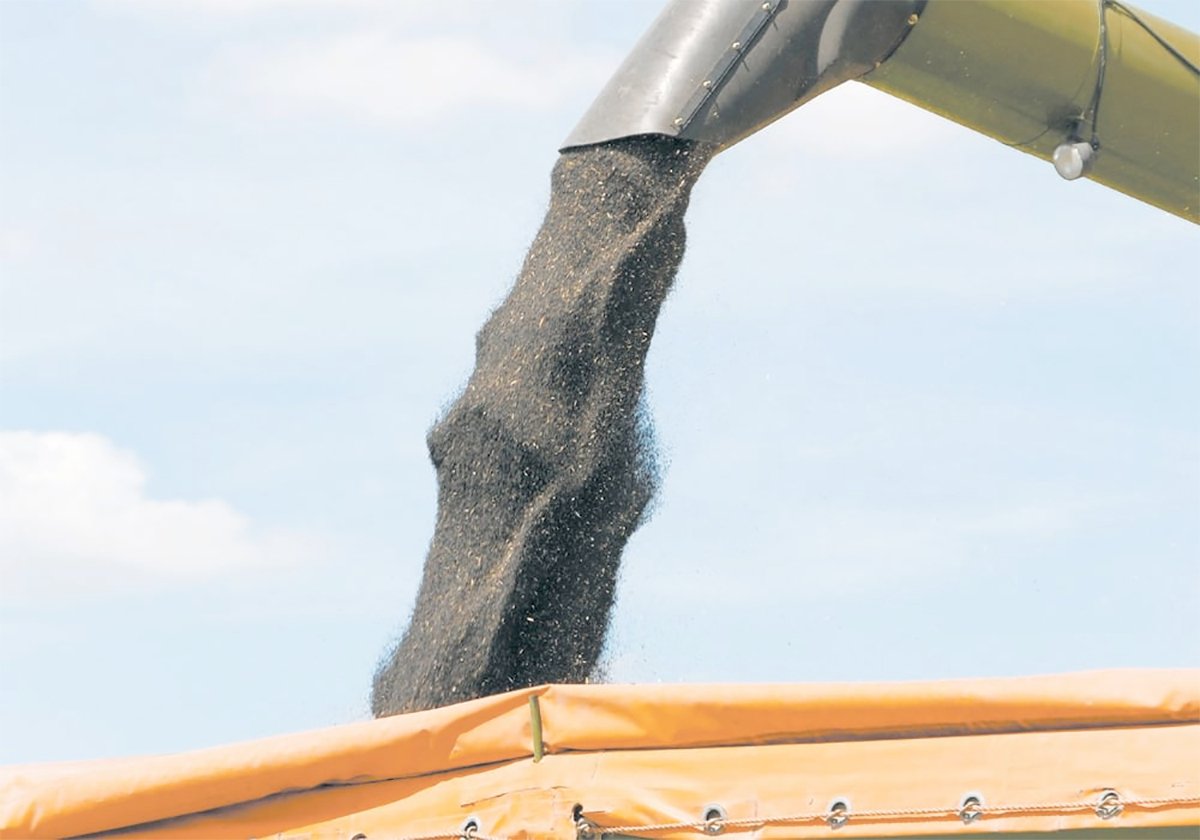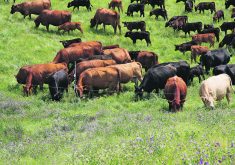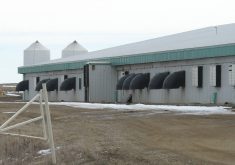Find backbone
I only have a few comments about the BSE situation. We have about 350 cows and we are suffering greatly.
My husband and I have been discussing R-CALF. How can they get another injunction to keep the border closed?
We feel that Canadians should get the border closed to American beef, for it is affecting our cattle sales. Why should we allow their beef here in Canada?
They have more cattle in the United States and you can’t tell me that they haven’t had a single case of BSE.
Read Also

Determining tariff compensation will be difficult but necessary
Prime minister Mark Carney says his government will support canola farmers, yet estimating the loss and paying compensation in an equitable fashion will be no easy task, but it can be done.
We also feel that Canada needs a backbone and should stop all boxed meat being shipped to the U.S. It is the only way to make the Americans see that we don’t need their markets.
We have more than enough markets in overseas countries and we can’t even supply them for lack of slaughtering plants.
But what I’m saying is supply other countries that are willing to take bone-in cuts and the like, and get these slaughtering plants up and running.
Two years is long enough. The government should have seen this coming and should stop wasting Canadian tax dollars and spend it on facilities to help out the cow-calf producers. What are they waiting for?
Ñ Candrin and Kevin Hammel,
Eddystone, Man.
Gov’t out
We are a farm family in Saskatchewan with a cow-calf herd.
The solution to the closed border and the associated financial stress on the agricultural community is not more government help or funds but less government interference.
Should we desire, we can produce and slaughter our beef as halal, kosher, Certified Angus, choice, etc. However, the Canadian government, through the Canadian Food Inspection Agency, will not allow us to test each animal for BSE, at our own cost of approximately $30 per head, and market the meat accordingly.
We are willing to bet that consumers worldwide, whether Canadian, Japanese or American, will not only be willing to pay two cents per kilogram more for Canadian cattle, 100 percent tested, but clamour for it.
Regardless of whether such tests are statistically necessary, this testing process will turn this problem into one of the biggest marketing coups ever.
Ñ Richard Pedde,
Indian Head, Sask.
Thrifty ’30s
At the present time we hear so much about strife within countries among people, like Yugoslavia with three or four main cultures: Muslims, Croats and Serbs.
In our day we also have many handing out food aid and missionaries running hospitals in improving Third World country’s standard of living.
I was born in the 1920s and raised in the distressful 1930s and anxious 1940s. My parents were drastically affected economically when I was in my teens, but we went on living.
My parents worked hard and provided well for our needs. There was a wonderful spirit of co-operation among people and a desire to help one another.
Then came the Second World War in 1939 and the economy started to pick up but the future was uncertain. …
In our farming area, in the ’30s, eggs sold for 10 cents per dozen, cream went for $2.50 to $5 a can; milk cows sold for $30. In harvest time wages were $4 per day for stooking and $5 per day for threshing.
My mother was wise in the economy of that time. She balanced her grocery shopping around the cream cheque and the sale of eggs. As parents they had a large garden and raised cattle, chickens, turkeys, and later pigs. She had time to feed lunch to men looking for work….
Now we have an uncertain future, but we can be optimistic like our forefathers to have faith God will bless us in our great country.
Ñ Clifford Caskey,
Ridgedale, Sask.
Who gets what
Much publicity is related to social and economic injustice directed against farmers. No wonder farmers more than any other kind of people are suffering from stress, depression, certain health problems; even suicide.
Colleen Ross at a Parliament Hill news conference pointed out that oat growers receive $140 per tonne. (WP, Feb. 10)
Added processing field oats into rolled oats isn’t an involved operation, yet the finished product from one tonne of oats sells for more than $3,000.
Ross blames this on agribusiness and the World Trade Organization, whose business ethic is to favour the multinationals. …
People like Brent McBean (WP, Feb. 10) feel if the farm socio-economy is to improve, political involvement is necessary. Which politics? To support one of the major national or provincial political parties as they presently function is much like mice hoping cats of a different colour will be kinder to them …
People like McBean seem to have the ability to become active in politics.
If the intent is to improve Canada’s socioeconomic situation, such people must work to eliminate corruption, replace the fractional reserve, debt-imposing money supply system with a system based on the production of real goods and services….
Ñ Stuart Makaroff,
Saskatoon, Sask.
Lousy steak
On March 2, the very day that Billings, Montana courtroom judge handed down a decision to temporarily impose an injunction on western Canadian cattle into that state, I was having supper.
I had just cooked a small steak that was purchased at one of our local stores, and which had cost me all of $4.23.
The label described the steak as, “top sirloin grilling steak Ð boneless.”
I was watching the 6:30 p.m. news (about) how Saskatchewan beef producers were upset at the Montana judge’s decision.
Ironically, the steak in question was so tough, I lost track of the gist of the news while trying to chop through the sinewy piece of shoe leather, which should have been used for a brake pad instead of a meal.
I did eventually eat it, but only by chopping it up into such small pieces that if I couldn’t finish it, I could at least provide the English sparrows in the backyard with a feast.
All fears of BSE set aside, if I were an American or Japanese or British consumer and this stuff came across my plate, I would be tempted to seek an injunction against any government that allows its producers to export this inferior product to a trading partner.
Perhaps it’s time we came to terms with reality and realized that sometimes, Canadians do make mistakes and there’s always room for improvement.
I’m not laying the blame on anyone in particular for my lousy steak.
I do, however, believe that ultimately, what ends up on a consumer’s plate is what will determine our reputation in domestic and foreign markets. Producers should be made aware of the consequences of selling an inferior product.
Ñ John Hamon,
Gravelbourg, Sask.
Grain futures
Are farmers happy with 1970 prices, content exporting $4 wheat to the U.S., to sell on the world market for $8?
If so, any concept of a Canadian family farm is doomed, ultimately to be taken over by mega corporations or gougers, where we can expect to pay three to five times more at the local food giant, also owned by the gougers.
For years they have been skimming world futures markets, except now they are getting really good at it, pushing fuel to unprecedented highs and grains to unrealistic, 28-year lows.
Try buying a grain contract. Are you willing to put up $20,000 US margin and take delivery of 5,000 bushels of wheat in Chicago? Gougers deflate prices simply by selling current and higher priced deferred contracts, then easily bluff out disorganized speculators for a loss. Grain prices are lower now than the early 1970s when crude was $3 a barrel….
Why can farmers not realize they have the power to solve this problem?… The power is in our ability to store grain until we get a decent price. Borrow against it if necessary.
Buying futures amounts to taking control of our commodities but doesn’t require extra bin space and can increase prices dramatically.
Placing profitable sale targets on all futures contracts amounts to getting a decent price. Gougers could not possibly force delivery if the grain is in our bins.
Consider that we set price when selling and delivering futures.
The best of all worlds, making money to increase grain prices so we can get more money for our grain Ñ this is a problem?
Ñ Louis K. Berg,
Sedalia, Alta.
Viral vaccines
There is no doubt that vaccines are one of the most beneficial aids to human survivability.
For example, it has been estimated that over half the population of North American would have been destroyed without a smallpox vaccine.
However, this powerful vaccine tool appears to have an equally powerful negative side when used with animals.
In the Feb. 5, 2004, issue of the Western Producer, an article from the Reuters News Agency in Bangkok, Thailand said this: “A decision by China’s poultry producers to vaccinate birds after an outbreak in Hong Kong in 1997 may have been a mistake and could have contributed to the current problem.” This problem is now know as the H5N1 avian flu virus.
Since 1997, the H5N1 avian flu virus has mixed with human influenza and unleashed a pandemic that is both imminent and inevitable according to the World Health Organization.
There are now recorded cases in Asia of human-to-human transmission resulting in death. In fact, WHO is predicting 25 percent of the human population could become infected, with a mortality rate of 75 to 80 percent.
Simple math extrapolates this to be a death sentence for roughly 20 percent of the human population, which equates to more than one billion people.
We have had more than 20 years to create a vaccine for the HIV virus without success. Moreover, more money on an annual basis is now being spent on HIV research and treatment than the next three large killers of mankind combined Ñ heart disease, stroke and cancer.
According to health experts of WHO, the H5N1 avian flu virus, like the HIV virus, is now exchanging and recombining its DNA before replicating. It makes for an unstable virus, which creates a situation whereby developing a human vaccine for the avian flu virus is as impossible as it has been for creating a vaccine for the HIV virus.
If this is the situation, we will have to deal with the estimated 20 percent mortality rate for the human population of this generation and generations to come as long as there is life on this planet.
This observation begs and demands a rational answer to the following question: If indeed viral vaccines used with animals are the cause or etiological explanation for diseases like HIV and the H5N1 avian flu, then why are we continuing to use them?
Has the profit motive become more important than human survivability itself? Can we raise our necessary meat supply for the human population without viral vaccines?
The answer to the last question is a resounding and absolute yes.
We have proven to ourselves over the last 12 years with a large commercial herd purchased throughout Western Canada for our feedlot south of Stettler, Alta.,that it requires nothing more than the proper minerals in their nutrition supply resulting in only a 1.5 percent death rate.
This is a lower death rate than what is normally encountered in commercial feedlots using all of the latest vaccines.
Vaccines are not required in animals to feed the world.
I am very concerned that we as a human species become honest regarding the outcome of using viral vaccines with animals.
In fact, this writer is hypothesizing that if we don’t become honest in this matter, human survivability itself will be eternally jeopardized.
This leaves me with my last questions for readers to dwell upon. Why has the Canadian government decided to spend $24 million on antiviral drugs for the avian flu, while not addressing the probable cause of such disease?
In fact, all the antiviral drug will accomplish is a slower death process. Finally then, has mankind become terminally genocidal?
Ñ Dr. Ralph Walker
Stettler, Alta.
Science based?
Remember the recent fiasco with the registration of Roundup Ready wheat?
Monsanto kept pleading that trivialities like “market acceptance” should not influence the registration process. “Substantial equivalence” (i.e. looks like a duck, sounds like a duck, must be a duck) negated further testing and even agronomic concerns such as unwanted glyphosate resistant volunteers were downplayed. Monsanto demanded “science based” regulation only.
So it was with interest that I read page 30 of the Jan.13 Western Producer. Seems like Monsanto doesn’t consider environmental studies necessary either, at least in Indonesia: “The (Securities Exchange Commission) charges also involved at least $700,000 of illegal or questionable payments made to at least 140 current or former Indonesian government officials…” to waive the required environmental impact study before Monsanto’s genetically modified crops could be grown.
Monsanto has agreed to pay $1.5 million in penalties. Quite affordable since last quarter net seed sales were $1.09 billion.
This behaviour is nothing new, so why do we tolerate the suggestion that less government regulation and enforcement will benefit the public?
The May 2004 report of the Seed Sector Advisory Committee on page 10 poses the following question: “How should industry and government adapt their respective roles in line with greater capacity for industry self-regulation and…?”
This is an absolute blind leap of faith in corporate benevolence.
Industry’s understandable quest to maximize return on investment demands that public needs be legislated and (that there be) legally enforced protection from fraud, skipped or “doctored” studies and outright bribery.
Ñ Lyle Wright,
Kerrobert, Sask.
Bring to heel
According to Agriculture Canada, Saskatchewan farmers had a negative net income of $166 million in 2004. It projects a much worse negative net income for 2005 at $486.4 million.
Yes, this is partly due to border closure to Canadian cattle and the very severe early frost of 2004, but is by no means the main reason for the problem.
Saskatchewan’s biggest industry is grain production. Our input costs are way out of line with the price that world markets will pay for our grain. I have said this before and I will say it again because it is the key to understanding the severe, ever-increasing economic problems faced by grain producers.
Due to modern farming methods, we have become huge users of goods and services that we must have to produce our crops.
These goods and services that we must have are controlled by a mere handful of transnational ag corporations who have the ability to charge whatever the traffic will bear. Competition among them just doesn’t exist.
As a result the cost of farmer inputs on average have increased tenfold. Fuel, for example, has increased nearly 2,000 percent. We can’t farm without it unless we want to return to horses.
Grain prices today have changed little from what they were 50 years ago. They have barely doubled.
Each year for many years, thousands of farmers have been forced or choose to leave the land. Our rural Prairies are rapidly becoming an uninhabited hinterland.
It has been said that for every three farm families that leave the land, one rural business or community institution will be forced to close its doors.
This already is very evident, in prairie villages and towns.
So, what is the solution? The Combines Act must be updated with some teeth in it. Legislation must be passed concerning profiteering. An auditor general could be appointed with the power to investigate offending ag corporations and if need be, lay charges.
The transnational ag corporations must be controlled and brought to heel.
If this doesn’t happen, farmers in the future will be little more than latter-day serfs on their own land under the domination of the ag corporations.
Ñ George E. Hickie,
Waldron, Sask.
Cow crisis
Regarding the cow crisis, on March 7 the border was to open. (Now) it looks like it will stay closed. A judge in Montana has ruled to keep it closed. It looks like president Bush has no say.
What happened to free trade? It is free trade one way. Montana farmers say if cattle come to the States, it would lower prices. Let’s look at what the States are doing to us.
U.S. farmers are hauling canola every day with B-trains. That has dropped the price of canola to $5 from $8. The U.S. farmer can take the $5 Cdn to get their subsidies and end up with $9 or more. The Canadian farmer must make it go on $5, way below cost of production.
The price of cows is so low, $200 doesn’t pay to haul them to market. The government must move now and get a farm program like the U.S. We must shut the border down and play hardball. …
We need to build plants to process cattle and ship to all countries around the world. We can’t depend on U.S. trade. Let’s take some of their markets. …
Ñ Jack Pawich,
Cartwright, Man.
Water deal
An item in the Feb. 17 issue of the Western Producer states that a task force established by the international joint commission has begun work to resolve “a dispute over water use raised by former Montana governor Judy Martz, who said Alberta is taking too much water.”
Under review is the water apportionment agreement embodied in a 1921 order. Wording of the item suggests that this will deal with “equal sharing of water from the St. Mary River” but no reference is made to the Milk River.
This appears to be the sequel to a (TV) documentary aired earlier this year of a town hall type meeting in Montana where the topic was irrigation; specifically the sharing of the Milk and St. Mary rivers. Among the impassioned statements made was the claim that the U.S. delegates to the original meeting in 1921 convened to apportion these waters had been hoodwinked or outmaneuvered by the Canadian delegation. …
The documentary included some input from Canadian specialists Ð input obviously not a part of the actual meeting Ð pointing out that Montana receives the entire flow of the Milk River but because of obsolete design, lack of maintenance, etc., of its delivery system much of this is lost en route to its intended destination.
Did unscrupulous Canadian negotiators actually hoodwink our poor gullible neighbours so long ago? Probably not; such a singular event should surely have been enshrined in our own folklore.
However, this issue smells like several other border challenges of the recent past Ñ hogs, wheat, lumber, etc. The attitude is “our administration has shown us their disdain for contrary international trade rulings so now is the time to grab for all we desire.” Will our reps on this new task force ensure that Canada gets a fair deal?
Ñ Howard Fredeen,
Lacombe, Alta.
Farms & help
The government recently announced a new immigration program. We are all aware that farming has seen a strong declining balance in the last few years. BSE is not the only issue to blame, as poor crops and markets add difficulties as well.
Now, the Manitoba government wants to attract young immigrant farm families in order to make the farming and agriculture economy of Manitoba thrive.
My dad heard agriculture minister Rosann Wowchuck speak about the program on the radio and it wasn’t a surprise that once again the government and our own agriculture minister is willing to help others before she will look the problem straight in the eyes and solve the issue.
Instead, now there is hope to attract immigrant families. Why doesn’t the government help farmers here and perhaps more families and generations like myself would consider committing to a farming career?
The program is targeted at families under the age of 40, with experience in farming or business. As the government prepares to help these immigrants start a farm here, what guarantee do they get that the families will actually succeed? Perhaps it would be smarter to invest money into our own farmers who have experience with markets, the land and the people…
Where does this leave Manitoba farmers, besides in jeopardy? The government is willing to support people overseas before thinking about helping our own and making certain that farmers of Manitoba can establish a lasting farm.
Manitoba farmers are in debt and have no way out besides selling everything due to many issues facing the agriculture economy….
Many children, such as myself, are not following in our parents’ footsteps because I’ve seen firsthand how cruel the government is to its food producers.
Therefore, tonight before I go to bed, I pray that God will watch over my family and I, as well as my fellow farmers, for if he doesn’t, who will? All I know is that the government sure won’t.
Ñ Ramona Garbald,
Gladstone, Man.
Smoky air
I agree with smokers who argue that their human rights are infringed by laws that ban smoking. I also feel that my human rights are infringed when I am compelled to breathe second-hand smoke that has the potential to affect my health.
So it boils down to which makes more sense. Is it easier for smokers to stop smoking or for me to stop breathing?
Ñ William Dascavich,
Vegreville, Alta.
Smokers’ rights
I would like to address the smoking issue. The segregation, social isolation and total intolerance imposed by self-righteous non-smokers and our government is appalling. We have been thrown not by will, but demand, to back alleys like social degenerates.
To have the basic human right of shelter abolished by law for smokers in the “free” country is a direct violation. By law, even farm animals must have shelter. Do we want to claim the inept responsibility of putting our smokers even below animals? …
Small town restaurants and especially bars are the hub of every small community, especially Saskatchewan. To alienate these townspeople from one another and prevent public discourse is certain death for a democratic society….
Where are all the smokers? Let us stand up and demand a public human rights inquiry, which is our right by law. Let’s get together, and demand our right as taxpayers and for once stop the non-smokers, the provincial government and city councillors from dictating and destroying our social lives…
Ñ David Adrian,
Saskatoon, Sask.
Nitrogen note
I was utterly astonished and disappointed by the Producer item “Nitrogen: fall vs. spring applied” (fertilizer) in the Feb. 10 issue.
The article failed to mention that if the most common forms of chemical nitrogen fertilizers are applied, whether on or in the soil, when temperatures are or become about five degrees C, the nitrogen may be changed to the nitrate form.
Over the months part of that form of nitrogen may be converted to the gas form, which is lost from the soil to the atmosphere where it is the worst of the greenhouse gases.
Ñ C. F. Bentley,
Edmonton, Alta.
Post-Crow era
An open question: who is accountable to Saskatchewan farmers in the post-Crow era?
According to an article in Weber Commodities newsletter taken from Farming Life: it is expected Germany may import rapeseed/canola for the manufacture of biodiesel, as Europe joins the legions of nations that direct fuel consumption toward renewable resources.
It is expected that a bushel of canola may fall to below $5 a bushel due to a large soybean crop anticipated out of Brazil. In Canada today on most farms, $5 canola would be below the cost of production.
In addition to biodiesel, production of ethanol consumes more and more bushels around the world, but not in Western Canada.
What is most amazing is that Canada is likely the world’s most export dependent grain producer, and landlocked Saskatchewan produces 50 percent of that grain.
After a brief sojourn of decent commodity prices, it seems we may be now entering a cycle of perhaps the lowest real commodity prices in history. If glutted world markets lead to increased carry over of on-farm stocks, the question of how and why the diversification failed Ñ since it was supposed to naturally follow and promised as an outcome of the demise of the Crow Ñ will become an important question to address. And really, in the face of a world finding increasing use of grains for renewable energy, why has export dependant Canada so dismally failed to diversify the use of the raw commodity, grain?…
We need one or the other:
1) An exit strategy.
2) A vision for the future.
Both Paul Martin and Ralph Goodale were chief engineers in dismantling the historic Crow Rate Agreement. … It is time for these leaders to now review their actions and advise what went wrong.
Why did the diversification strategy that was supposed to naturally follow the demise of the Crow rate fail to materialize? Did we fail due to lack of government directive and policy?…
Did we fail to equate how much the Crow rate subsidy was a vital part of the formula in keeping the export grain sector profitable, especially in Saskatchewan?
Or was the industry ever sustainable and are things merely unfolding as they should?
Indeed, should we hold the current federal leadership accountable for the result?
In my opinion very much so. …We need a plan. We need it now.
Ñ Vicki Dutton,
Paynton, Sask.
AU meeting
On Feb. 9 to 10 this year I had the privilege to represent Member Association Group 226 at the Agricore United annual meeting.It wasn’t long before I wondered if I had not taken a wrong turn and ended up at the Western Canadian Wheat Growers meeting.
The room was full of WCWGA supporters as if they had nowhere better to be at this time of year. I was surprised that no one took the board to task after the financial report was read, and I thought that if no one was worried, then why should I complain…?
The first resolutions, having to do with the demise of the Canadian Wheat Board, gave the feeling that life would be so much better only if we could get rid of the board.
The reality is that the CWB was the chosen instrument of the federal government to protect western Canadian farmers against the manipulation of the multinational grain companies. It is the law of the land, sanctioned and supported by the federal government.
It is true that on some occasions some farmers may have prospered without it, but western Canadian agriculture as a whole is better off with a central marketing agency. Get used to it.
If you really want choice there is a lot of land south of you, where you will have plenty of choices to make. Do not ruin it for those of us that are doing well in the present system. …
Agricore United is in no shape to alienate anyone. They must welcome everyone to their doors, and we should not be passing resolutions that will deter from their bottom line.
The issue of size came up. It seems that large farmers have a monopoly on brains, and they should have more votes than small farmers.
The issue is economics, not size. A farmer farms as many acres as he feels necessary to meet his goals and needs. If you are uneconomical at 1,000 acres, then you must farm 5,000 acres to make up for your inefficiencies….
We must work together and come forward with resolutions that will improve Agricore United’s bottom line, ones that unite farmers, as the name implies.
We cannot raise the world price by fighting amongst ourselves; the world price is the price. What we can do is lobby Agricore United to lobby the provincial and federal government to lower our taxes, cut our costs of farming in Canada, to make sure that tax collected in Western Canada stays in Western Canada.
We must promote … things that the world wants to pay that little bit extra for that will improve my bottom line.
Ñ Dale Gryba,
Gilbert Plains, Man.














